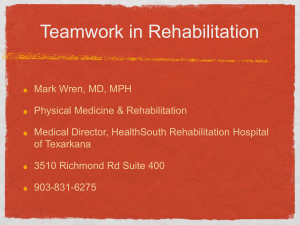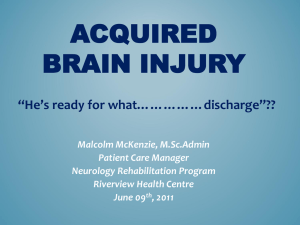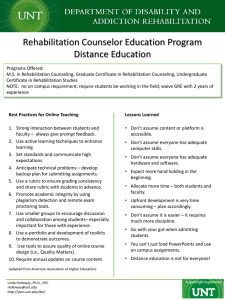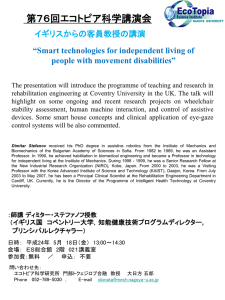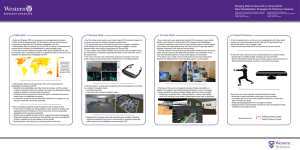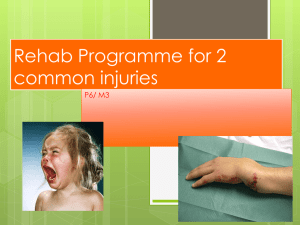Wrist and fingers home rehabilitation device
advertisement
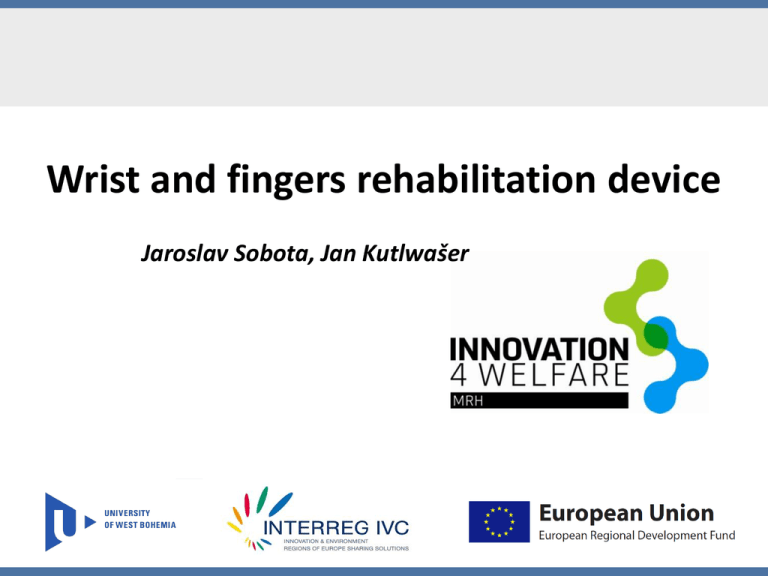
Wrist and fingers rehabilitation device Jaroslav Sobota, Jan Kutlwašer Wrist and finger home rehabilitation device Smart mechatronic device complementing or replacing existing mechanical aids • Rehabilitation of wrist and fingers after surgical treatment of flexor/extensor tendons • Rehabilitation of neurological pacients – stroke, brain and spinal cord injury, Parkinson disease, multiple sclerosis Mechatronics-based Rehabilitation at Home 2 MRH device requirements User: • Intuitive graphical interface, ideally making the excersises fun • Ergonomic design M.D. / Physiotherapist: • Remote monitoring of rehabilitation activities (frequency, efectiveness) • Remote adjustment of the excersises Manufacturer / Service provider: • Remote functionality diagnostics and service (firmware upgrade) Legislative and regulatory: • Safety, data security Mechatronics-based Rehabilitation at Home 3 Project team Department of Cybernetics • R&D in embedded and distributed control systems and algorithms for process control, robotics and mechatronics Department of Machine Design • Prototype development • New study programme „Construction of medical equipment“ Mechatronics-based Rehabilitation at Home 4 Brief description of the device • Exoskeleton architecture • Real-time measurement and control • Graphical user interface • Data archiving, remote access Mechatronics-based Rehabilitation at Home 5 Control algorithm • Graphical programming in the REX control system • Bottom-up development • Individual control of each phalanx in continuous passive motion (CPM) mode • Defined velocity, acceleration and maximum angle Mechatronics-based Rehabilitation at Home 6 Definition of exercises • Sequential state machine programmed in SFC Editor • Chain of conditioned actions • Each state triggers movements of individual phalanxes • Once the transition condition is fulfilled (angle is reached), next state is activated • Once all the actions are performed, the cycle returns to initial state and can be repeated Mechatronics-based Rehabilitation at Home 7 User interface • Java-based visualization framework • Real-time visualization of the exercise - animated 3D models (based on measured data) - running 2D plots (based on measured data) - exercise parameters • Can be used locally or for remote supervision • Straightforward design from CAD drawing Mechatronics-based Rehabilitation at Home 8 Simulation of exercises • • • Verification and/or visualization of the exercise Avoiding movements beyond ROM Preparing patient for the exercise • Minor changes for guiding the patient through active exercises, the requested movement or target position is displayed Mechatronics-based Rehabilitation at Home 9 Highlights of our approach • REX control system is compatible with Matlab/Simulink • Control algorithm can be easily verified before deployment • No coding required, transfer to target platform is straightforward • Visualization and user interface framework is available • All parameters of the exercises can be changed over the internet • Records of exercises are stored and can be used to evaluate the progress of rehabilitation treatment Mechatronics-based Rehabilitation at Home 10 Philosophy of hand rehabilitation device • Whole device is modular assembly • there are two basis (one for left hand and one for right hand) • “fingers” of mechanism are in different sizes for each phalanx • thumb’s holder is in more than one size • servos, screws, are the same • Fingerholders are cleanable or changeable Mechatronics-based Rehabilitation at Home 11 Philosophy of hand rehabilitation device Hand rehabilitation device cycle exercise program setup by therapist patient use it at home patient returns the device device is assembled for specific patient therapist checks the exercise and changes exercise program values the device is disassembled parts are stored for new usage some parts are renewed Mechatronics-based Rehabilitation at Home 12 Simplified design – the 1st design Mechatronics-based Rehabilitation at Home 13 Simplified design – the new one Mechatronics-based Rehabilitation at Home 14 Simplified design – pros and cons • Advantages of the new design: • less number of parts • easiest assembly • measuring system in the servos could be used • Disadvantages of the new design: • rods of mechanism are slightly moved from center of axis Mechatronics-based Rehabilitation at Home 15 1st physical prototype •Prototype for software tests and modularity tests •Designed in “Design for Cost” philosophy Summary • Insight into research and development at UWB within the MRH project • The software and hardware part of the hand rehabilitation device • The development continues … Mechatronics-based Rehabilitation at Home 17 Summary • Insight into research and development at UWB within the MRH project • The software and hardware part of the hand rehabilitation device • The development continues … Thank you for your attention Contact: Jaroslav Sobota (jsobota@kky.zcu.cz) Jan Kutlwašer (kutlis@kks.zcu.cz) Josef Formánek (formanek@kks.zcu.cz) Mechatronics-based Rehabilitation at Home 18


